Healthcare Distribution Market Size
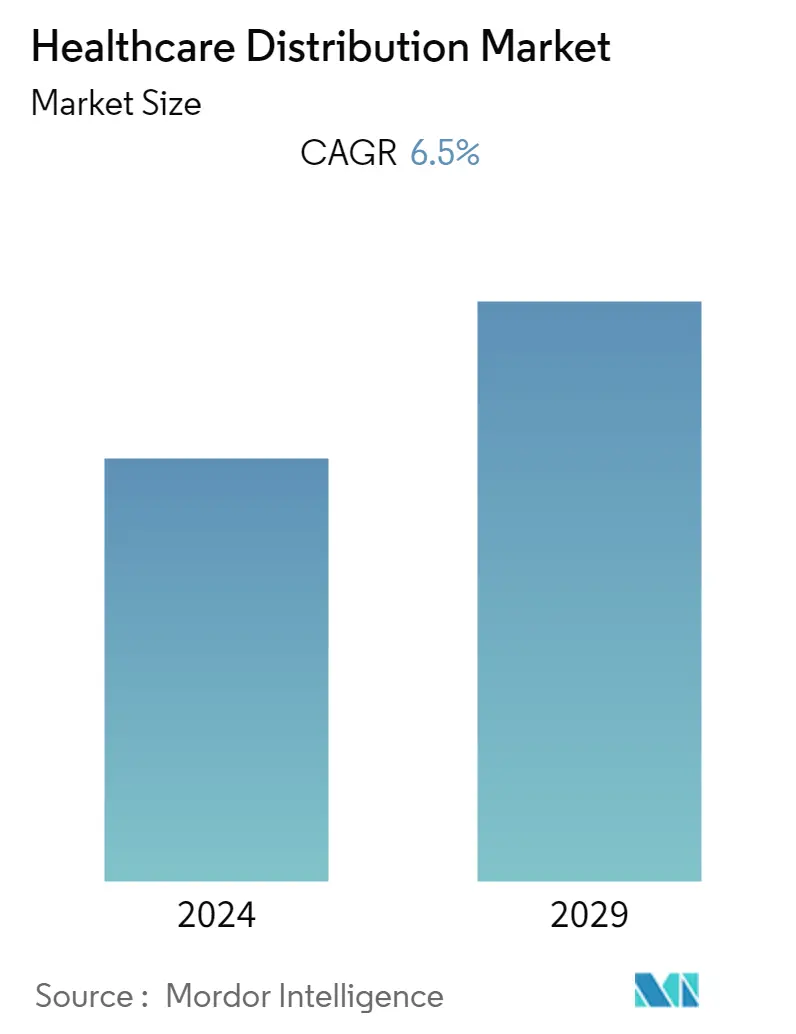
| Study Period | 2018 - 2028 |
| Base Year For Estimation | 2021 |
| CAGR | 6.50 % |
| Fastest Growing Market | Asia-Pacific |
| Largest Market | North America |
| Market Concentration | Medium |
Major Players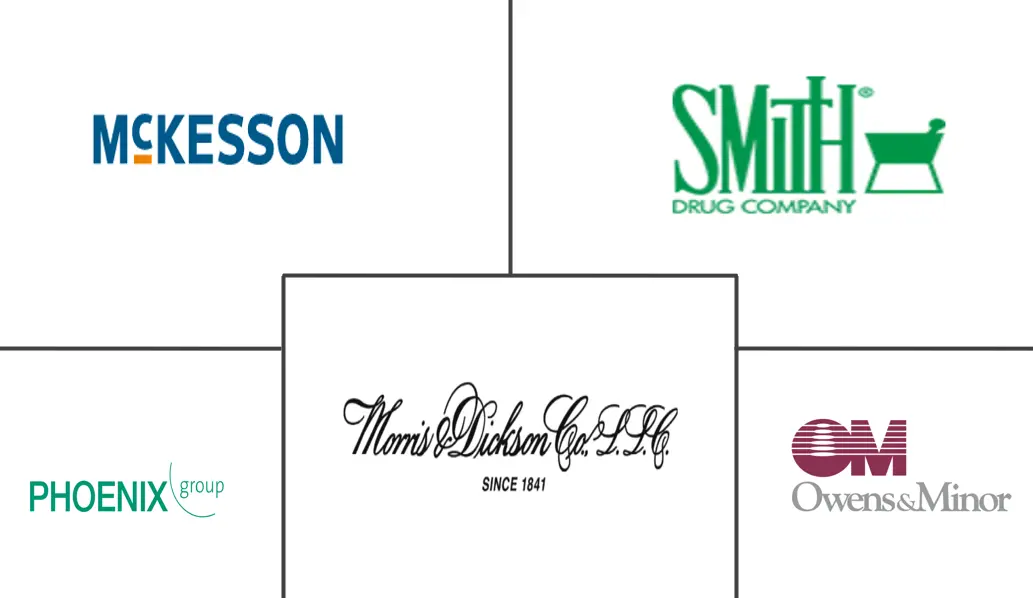
*Disclaimer: Major Players sorted in no particular order |
Need a report that reflects how COVID-19 has impacted this market and its growth?
Healthcare Distribution Market Analysis
The healthcare distribution market is expected to register a CAGR of 6.5 % over the forecast period, 2022-2027.
COVID-19 pandemic was an incomparable global public health emergency, it has impacted almost every sector of the industry including the healthcare distribution market industry. The strict lockdowns and government regulations intended to slow down the spread of COVID-19, by restricting the movement of people. Lockdown has impacted the sales of the healthcare distribution market initially but over some time market has gained significant growth. For instance, in 2021 an article published in the journal, Maritime Economics, and Logistics, summarizes that COVID-19 impacted the manufacturing activity and caused disruptions in transportation and logistics activities globally, these factors lead to a sudden and drastic fall in the healthcare distribution services. Within a few weeks of the COVID-19 crisis a considerable change in consumer behavior and demand, consumer purchase patterns, re-routing of the supply chain, and significant government intervention was observed. The supply chain disruptions during the initial phase of lockdown were a major downfall for the distribution market resulting in a slowdown in the healthcare distribution activities and this led to setting up a strong supply chain network for efficient healthcare distribution services. The disease will inevitably be an overwhelming burden on healthcare systems that cannot be effectively dealt with by existing facilities or responses based on conventional approaches. All these long-term effects of COVID-19 have caused challenges for healthcare distribution services.
With the large economic burden of chronic diseases, technological advancement in distribution, favorable R&D investment scenario, and subsequent increase in drug launches are the main driving features of the healthcare distribution market. For instance, in 2022, the National Institution of Chronic Disease and Data reported that nearly 60% of adult Americans have at least one chronic disease and about 40% of American adults have multiple chronic conditions (MCC). Chronic conditions like diabetes, cancer, and cardiovascular disease are the leading causes of death in the United States. To cure these disorders, cellular treatment, biomarker imaging, generics, biosimilars, and other wide range of healthcare medications are used. These created necessities for effective healthcare distribution services. Generics are also in high demand due to their cost-effectiveness. Furthermore Thus, increasing cases of chronic disease are driving the healthcare distribution market.
The growing need for medical device equipment such as in-vitro diagnostic equipment, diagnostic imaging equipment, and endoscopic equipment which are used in this healthcare industry for a variety of functions is driving the above market. Thus a safe and effective delivery network in the healthcare distribution market is required which can fulfill the need of consumers and thus can significantly aid the market growth. Technological advancements in distribution are boosting the healthcare distribution market. For instance in 2021, according to the article published in ScienceOpen.com titled, Applications of Artificial Intelligence (AI) Healthcare: A review summarizes that with the coming of technologies such as Artificial Intelligence, machine learning, and other technologies, the healthcare distribution market sector has witnessed an advanced change. Adopting IoT (Internet of things) technologies has given distributors real-time information about their pharmacies and provider clients. This allows them to provide with consistent supply schedule. IoT (Internet of things) technology also has diversions by algorithms to assess if the delivery route is not followed or if an unusual delay had occurred. Due to this advanced technology and safe and effective delivery tracking system, there is increasing growth in the healthcare distribution market.
Advanced technologies and increased chronic disease cases are the factors likely to boost the adoption of the healthcare distribution market, thereby contributing to the studied market growth. Therefore, owing to the aforementioned factors the studied market is anticipated to witness growth over the analysis period. The high cost and investment associated with the healthcare distribution services are expected to hamper the overall growth of this market.
Healthcare Distribution Market Trends
This section covers the major market trends shaping the Healthcare Distribution Market according to our research experts:
Retail Pharmacy is Expected to Witness a Significant Growth Over the Forecast Period
A retail pharmacy is defined as any pharmacy where drugs are compounded, dispensed, stored, or sold or where prescriptions are filled or dispensed to the general public. The retail pharmacy daily deals with a large number of prescriptions and is thus expected to drive this market. In developed countries, the high availability of healthcare schemes and programs led to a significant increase in the number of prescriptions. in 2021, an article published in the journal Integrated pharmacy research and practice, summarizes the high affordability and availability of pharmaceutical drugs especially generic drugs in retail pharmacy stores, the government has also imposed the clinical pharmacy practice in recent years which has increased the number of pharmacists working in clinically advanced roles worldwide, this has resulted in better pharmacist-provided services and clinical interventions have been shown to reduce the risk of potential adverse drug events and improve patient outcomes, and the pharmacist activities are cost-effective or have a good cost: benefit ratio. These benefits associated with it are increasing the demand for this segment over the forecasted period.
The growing incidence of chronic diseases like hypertension, diabetes, cardiovascular diseases, and cancer, which require prolonged medication, is directly related to an increase in the number of prescriptions, which further can drive the growth of the retail pharmacy market during the forecast period. For instance, DiabetesAtlas.org 2021 reported that about 536.6 million people were estimated to have diabetes in 2021 and this number will increase to 642.7 million by 2030. Thus, the high prevalence rate of chronic diseases like diabetes is expected to drive this market. Due to above mentioned aforesaid reasons, retail pharmacies have witnessed significant growth over the forecast period.
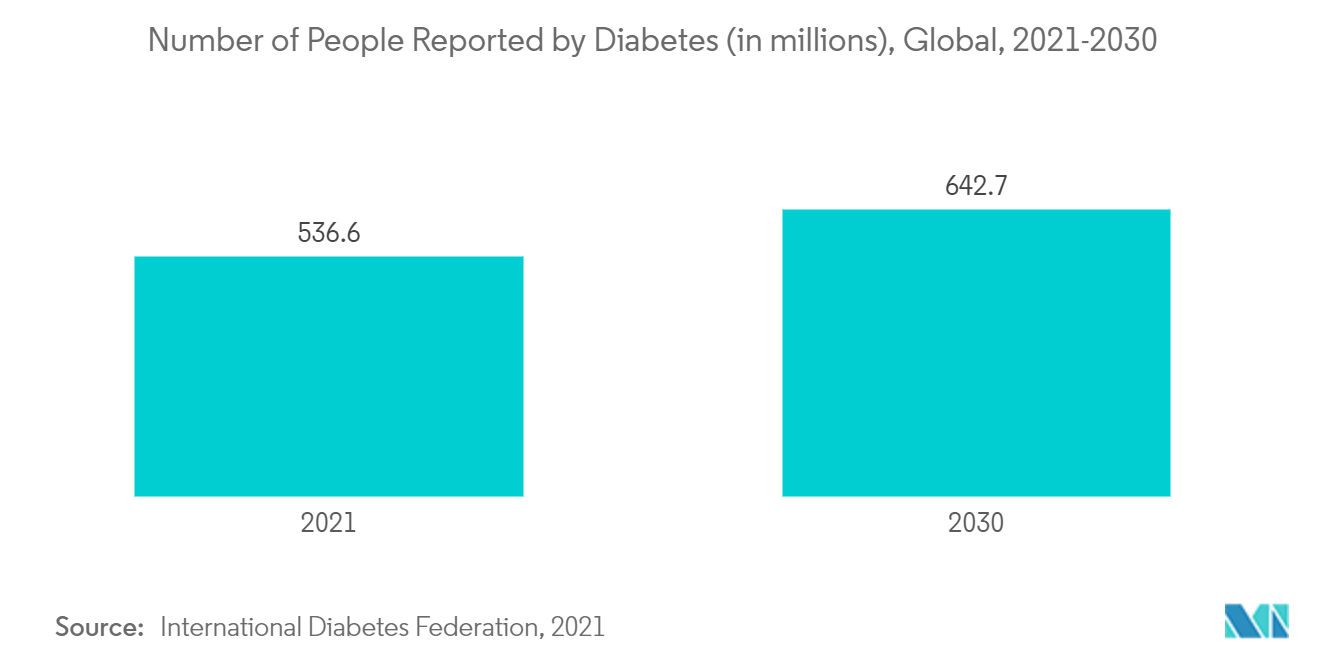
North America is Expected to Dominate the Healthcare Distribution Market
North America is expected to dominate the market owing to factors such as the rapid expansion of the pharmaceutical and biopharmaceutical industry, rising demand for specialty drugs and generics, and large-scale adoption of advanced technologies such as Artificial Intelligence and blockchain in the healthcare sector. With the rapid advancement of technologies and the coming of AI-based technologies have improved the supply chain efficiency of healthcare distribution services. The use of artificial intelligence technology has boosted distribution practices globally. For instance, in 2021 according to the journal SAGE, an article titled, “Digital Transformation: An Overview of the Current of the Art of the Research” summarizes that by using (Artificial Technology) AI, businesses can offer shipment updates to customers. When tracking technology fails, an (Artificial Intelligence) AI system can track the delay in the delivery so companies can easily provide an estimate of delivery time to their customers. These programs can analyze things like average shipment times and weather patterns to offer accurate results. Proper computational data generated by these technologies ensure the effective distribution of healthcare services and make the entire distribution process convenient. Moreover, with the significant increase in the number of prescriptions filled at retail pharmacies, and effective supply chain management, distributors have turned to modern industrial technology such as machine learning and Artificial Intelligence for big data and standardized influence, due to this the healthcare distribution market is effectively growing in the United States. Using AI technologies in healthcare, coupled with patients’ growing adoption of AI-enabled devices, allows collection and storage of and access to large-scale data, both by healthcare providers and technology vendors.
Further, advanced healthcare infrastructure and increasing investments by biotechnology companies in research activities are expected to drive market growth in the region. The infrastructure and along with the skilled manpower can also be an initiative to increase the efficiency of the healthcare distribution services. For instance, Tecsys Inc, a Canadian healthcare distributor company reports that the proper infrastructure of the warehouse management system can provide the efficient strategic potential of the supply chain and maintains the healthcare distribution market into a transparent, efficient, and optimized network. The company’s patented visual logistic technology has provided clear visual instructions to increase efficiency and accuracy.
For another instance, in 2022 Cardinal Health a distributor of pharmaceuticals acquired Scala Med a HIPAA-compliant, smart platform that transfers prescriptions directly to patients via a secure mobile app. ScalaMed pivots prescription management from provider to patient, allowing patients to send prescriptions written by their provider directly to any pharmacy for the first fill. The platform offers patients greater flexibility, easier access, and price comparison to select the pharmacy of their choice. This acquisition will result in reduced administrative burden and better connectivity while prescribing the drug, which will result in better healthcare distribution services at various levels.
Therefore, owing to the aforesaid factors the growth of the studied market is anticipated in the North America Region.
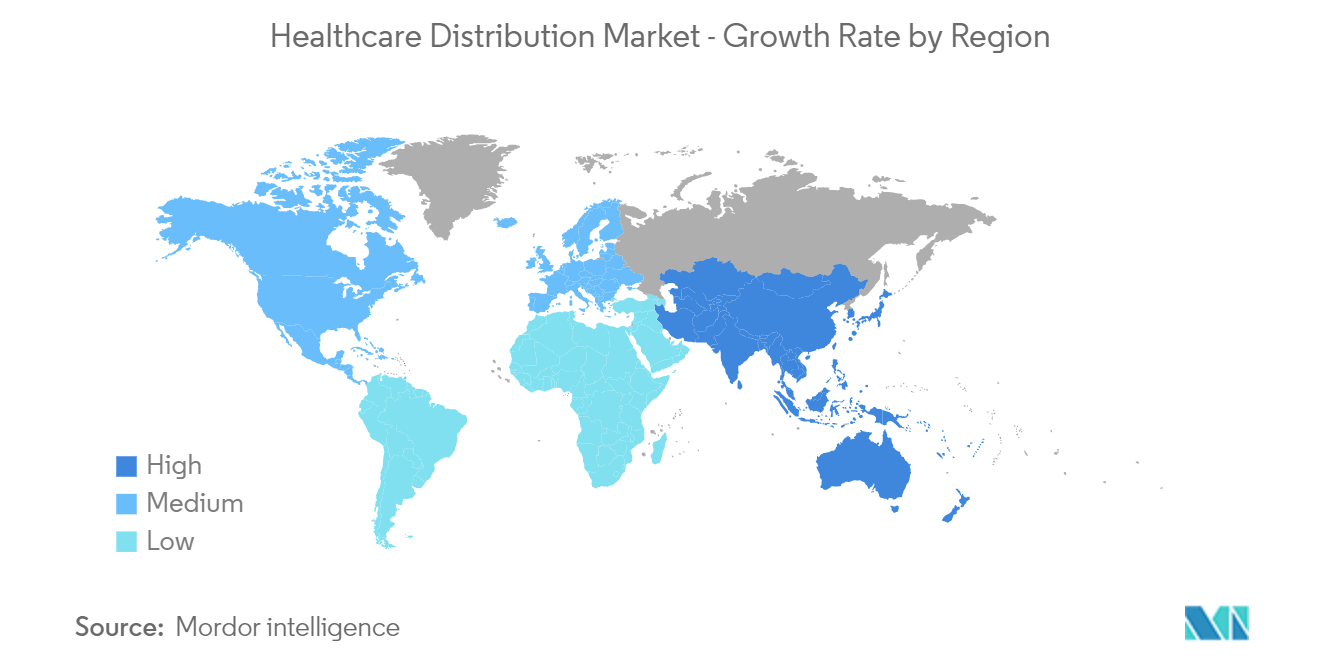
Healthcare Distribution Industry Overview
The healthcare distribution market is fragmented in nature due to the presence of several companies operating globally as well as regionally. The competitive landscape includes an analysis of a few international as well as local companies which hold the market shares and are well known as McKesson Corporation, Cardinal Health, Morris and Dickson Company, Smith Drug Company, Owens and Minor Inc., Patterson Companies, PHOENIX Group, Owens, Medline Industries, Other Companies.
Healthcare Distribution Market Leaders
McKesson Corporation
Smith Drug Company
Morris and Dickson Company
Owens and Minor Inc
PHOENIX Group
*Disclaimer: Major Players sorted in no particular order
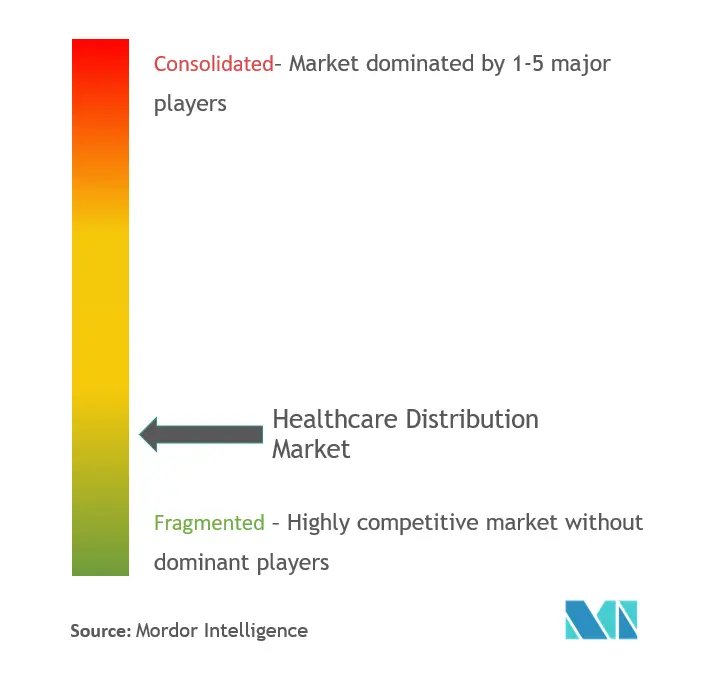
Healthcare Distribution Market News
- In April 2021, Diethelm Keller Siber Hegner, a multi-national company completed the acquisitions of the Korean Life sciences distributer leading to solidifying its position as a leading Pan-Asian provider of scientific instrumentation and acquisitions of Singapore-based medical device distributor MedWorkz further leading to its expansion of medical device business to Singapore.
- In March 2021, Cardinal Health and FourKites have established a global corporation to improve the tracking of pharmaceutical equipment like first aid supplies, and personal protective equipment in transit to hospitals, pharmacies, and other care facilities throughout the world.
Healthcare Distribution Market Report - Table of Contents
1. INTRODUCTION
1.1 Study Assumptions and Market Definition
1.2 Scope of the Study
2. RESEARCH METHODOLOGY
3. EXECUTIVE SUMMARY
4. MARKET DYNAMICS
4.1 Market Overview
4.2 Market Drivers
4.2.1 High Incidence and Large Economic Burden of Chronic Diseases
4.2.2 Technological Advancement in Distribution
4.2.3 Favorable R&D Investment Scenario, and Subsequent Increase in Drug Launches
4.3 Market Restraints
4.3.1 High Cost of Healthcare Distribution
4.4 Porter's Five Force Analysis
4.4.1 Threat of New Entrants
4.4.2 Bargaining Power of Buyers/Consumers
4.4.3 Bargaining Power of Suppliers
4.4.4 Threat of Substitute Products
4.4.5 Intensity of Competitive Rivalry
5. MARKET SEGMENTATION (Market Size by Value - USD million)
5.1 By Product Type
5.1.1 Pharmaceutical Product Distribution Services
5.1.1.1 Over The Counter Drugs
5.1.1.2 Generic Drugs
5.1.1.3 Branded Drugs
5.1.2 Biopharmaceutical Product Distribution Service
5.1.2.1 Recombinant Proteins
5.1.2.2 Monoclonal Antibodies
5.1.2.3 Vaccines
5.1.3 Medical Devices Distribution Services
5.2 By End-User
5.2.1 Retail Pharmacies
5.2.2 Hospital Pharmacies
5.2.3 Other End-Users
5.3 Geography
5.3.1 North America
5.3.1.1 United States
5.3.1.2 Canada
5.3.1.3 Mexico
5.3.2 Europe
5.3.2.1 Germany
5.3.2.2 United Kingdom
5.3.2.3 France
5.3.2.4 Italy
5.3.2.5 Spain
5.3.2.6 Rest of Europe
5.3.3 Asia-Pacific
5.3.3.1 China
5.3.3.2 Japan
5.3.3.3 India
5.3.3.4 Australia
5.3.3.5 South Korea
5.3.3.6 Rest of Asia-Pacific
5.3.4 Middle East and Africa
5.3.4.1 GCC
5.3.4.2 South Africa
5.3.4.3 Rest of Middle East and Africa
5.3.5 South America
5.3.5.1 Brazil
5.3.5.2 Argentina
5.3.5.3 Rest of South America
6. COMPETITIVE LANDSCAPE
6.1 Company Profiles
6.1.1 McKesson Corporation
6.1.2 Cardinal Health
6.1.3 Morris and Dickson Company
6.1.4 Smith Drug Company
6.1.5 Owens and Minor Inc
6.1.6 Patterson Companies
6.1.7 PHOENIX Group
6.1.8 Shanghai Pharmaceutical Group
6.1.9 Medline Industries
6.1.10 CuraScript SD
6.1.11 Mutual Drug
- *List Not Exhaustive
7. MARKET OPPORTUNITIES AND FUTURE TRENDS
Healthcare Distribution Industry Segmentation
As per the scope of the market, healthcare distribution refers to entire distribution practices in the healthcare sector used for enterprise resource planning, customer relationship management, medical and pharmacy supplies, wholesaling medications, along with distribution and associated services. The healthcare distribution market is segmented by Product Type (Pharmaceutical Product Distribution Services (Over the Counter Drugs, Generic Drugs, and Branded Drugs), Biopharmaceutical Product Distribution Services (Recombinant Proteins, Monoclonal Antibodies, and Vaccines), and Medical Devices Distribution Services), End-User (Retail Pharmacies, Hospital Pharmacies, and Other End-users), and Geography (North America, Europe, Asia-Pacific, Middle East, Africa, and South America). The report offers the value (in USD million) for the above segments. The report offers the value (in USD million) for the above segments. The market report also covers the estimated market sizes and trends for 17 different countries across major regions, globally. The report offers the value (in USD million) for the above segments.
| By Product Type | |||||
| |||||
| |||||
| Medical Devices Distribution Services |
| By End-User | |
| Retail Pharmacies | |
| Hospital Pharmacies | |
| Other End-Users |
| Geography | ||||||||
| ||||||||
| ||||||||
| ||||||||
| ||||||||
|
Healthcare Distribution Market Research FAQs
What is the current Global Healthcare Distribution Market size?
The Global Healthcare Distribution Market is projected to register a CAGR of 6.5% during the forecast period (2023-2028).
Who are the key players in Global Healthcare Distribution Market?
McKesson Corporation, Smith Drug Company, Morris and Dickson Company, Owens and Minor Inc and PHOENIX Group are the major companies operating in the Global Healthcare Distribution Market.
Which is the fastest growing region in Global Healthcare Distribution Market?
Asia-Pacific is estimated to grow at the highest CAGR over the forecast period (2023-2028).
Which region has the biggest share in Global Healthcare Distribution Market?
In 2023, the North America accounts for the largest market share in the Global Healthcare Distribution Market.
Global Healthcare Distribution Industry Report
Statistics for the 2023 Global Healthcare Distribution market share, size and revenue growth rate, created by Mordor Intelligence™ Industry Reports. Global Healthcare Distribution analysis includes a market forecast outlook to 2028 and historical overview. Get a sample of this industry analysis as a free report PDF download.
